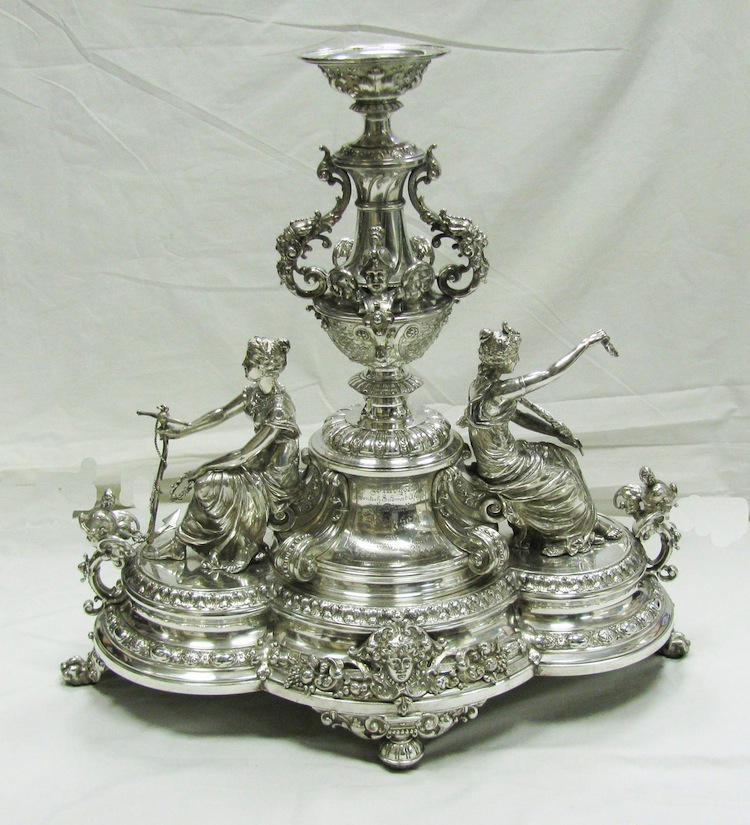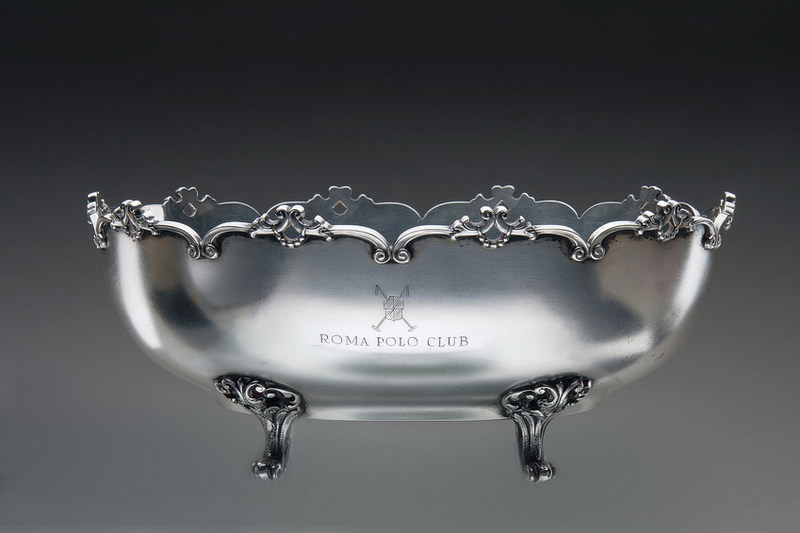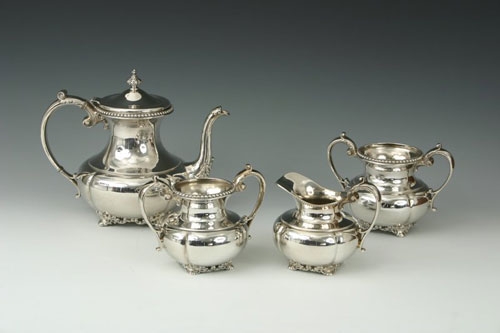The crown & crescent are the state mark and are followed by a numeric standard mark and usually a maker’s mark (symbol, initials or full name). Prior to 1884, instead of the crown & crescent, each city had its own symbol and silver purity was sometimes marked on the lothige system with a number 12 or more commonly 13.

Assay marks for silver purity found on German and Polish silver of the 18th & 19th centuries.
The Loth system divided silver into 16 parts. 16/16 for pure silver 15=.937 14=.875 13=.812 12=.750

Individual City & Town marks were used until 1884:
Augsburg City
Mark Beginning in 1763, a letter was added below the pomegranate to indicate the date.

Berlin City Mark
Beginning in the mid-18th century, a letter was added within the standing bear’s circle to indicate the date

Dessau City Mark
Variations on the block letter D was used from the 17th century through the early 19th century when it was changed to a script letter D.

Dresden City Mark
Variations on the crossed swords and D were used from the early 18th century through the late 19th century.

Frankfurt am Main City Mark
Illustrated is a late 18th cent. example, earlier versions lacked the standard number and were in a circular cartouche, sometimes with an F on the eagle’s breast.

Goerlitz City Mark
Sometimes seen with a “12” included above the crown.

Hamburg City Marks ~ 19th Century
Included with maker’s marks. The three tower and gate mark was used from the 17th century and was rendered within of a shield form until the late 18th cent. Beginning in the early 18th century, a letter was placed within the castle gate as a date mark.

Hanau City Mark
Seen with or without the loth number above the chevrons. Beginning in the mid 19th Century, hallmarking rules were rescinded and many Hanau silversmiths used antique looking ‘fantasy’ marks.

Kassel City Mark
The shield form evolved into a circle in the latter eighteenth century and a date letter was added below.

Lubeck City Mark
Variations on the double headed eagle were used from ca.1500 through the 18th century

Munich City Mark 1824 (München)
The angel was used, in one form or another, from the 17th century to the late 19th century, date numerals began in the mid 18th century.

Prussia Region
Used in the 19th century.

Saulgau City Mark
![]()
Stuttgart City Mark
The rearing horse was used in the 16th & 17th centuries. From the 18th through late 19th century, it evolved into a running horse and acquired a date code letter below his belly.

The German State crescent moon & crown mark replaced the individual city marks in 1884. The crown & crescent moon are used in conjunction with a maker’s mark and a decimal silver standard mark. Common silver standards are .800 & .835- .830, .900, .925 and .935 purities are also used.
Franz Bahner
Dusseldorf Mark used 1895 – 1917, see Mansfelder Silber

Wilhelm Binder
Schwäbisch Gmund founded 1869
![]()
Hugo Bohm
Schwäbisch Gmund founded 1887

Bremer Silberwarenfabrik
Bremen 1905 – 1981
![]()
Bremer Silberwarenfabrik (BSF)
Bremen Division of Wilkens since 1981, specializing in modern design flatware.
![]()
Bruckmann & Söhne
Heilbronn founded 1805

Gebrüder Deyhle
Schwäbisch Gmund founded 1820

Garagnon
Pforzheim active c.1930’s to 1960’s

Jakob Grimminger
Schwäbisch Gmund founded 1893

Theodor Julius Gunther
Berlin Succeeded by Robert Freund
![]()
Gustav Haegermann
Burgdorf / Hannover

Hanseatische Silberwarenfabrik Bremen

Gustav Hauber
Schwäbisch Gmund1870 – Present

Theodor Heiden
Munich / München b.1853 – d.1928

Emil Hermann
Waldstetten1921 – Present

Otto Hintze
Hamburg
![]()
Gebrüder Köberlin
Döbeln founded 1828

Koch & Bergfeld
Bremen founded 1829

Gebrüder Kühne
Schwäbisch Gmund Active ca. 1900-1940

Louis Kuppenheim
Pforzheim Active ca. 1900-1940

Langer & Gunther
Lichtenstein-Callenberg
![]()
Lutz & Weiss
Pforzheim founded 1882

Adam Manns & Sohne
Doernigheim
![]()
Adolf Mayer
Frankfurt am Main Jugendstil period, jewelry and holloware

Arthur Möhrle (Moehrle)
Schwäbisch Gmund 1895 – Present

Mansfelder Silberwarenfabrik (Franz Bahner)
Mansfeld 1917 – 1969
![]()
Franz Mosgau
Berlin founded 1807

Kurt Poetzsch
Weissenfels Active ca. 1925 – 1960

Lazarus Posen
Frankfurt am Main Active ca. 1870 – 1930

Gebrüder Reiner
Krumbach Bayern 1874 – Present.
a. 1899 – 1924
b. 1924 – 1949

Robbe & Berking
Flensburg 1874 – Present
![]()
Rossdeutscher & Reisig
Breslau

J. D. Schleissner Söhne
Hanau Founded 1816 – Present

Hermann Spliedt
Itzehoe founded 1857

Rudolf Trunck
Strasbourg Active ca. 1900 – Jugendstil style.

Vereinigte Silberwarenfabriken
Düsseldorf founded 1810

E. L. Vietor
Darmstadt Active ca.1890-1910

M. H. Wilkens & Söhne
Bremen-Hemelingen founded 1810

Otto Wolter Silberwarenfabrik
Schwäbisch Gmund

Württembergische Metallwarenfabrik (WMF)
Geislingen 1853-Present
![]()
Silverplate Mark (WMF)
Geislingen ca. 1900












